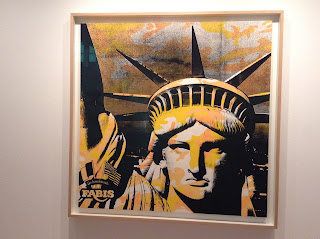Returning from a big Andy Warhol exhibit at the Art Gallery of Ontario:
The interpretive panels from the curators, and the audio guide, insistently aver that Warhol, with his Campbell Soup Cans and so forth, or sticking a French ad in his painting of the Statue of Liberty, was making ironic comments on American consumerism, mocking American pretentions of “liberty” and “democracy.”
I don’t believe that. That is just what the cynical cognoscenti want him to be doing, and perhaps assume he must be doing. There is nothing in the works themselves to signal ironic intent, and if there is not, we have no business assuming one. Warhol’s Campbell Soup Cans are unpretentiously beautiful. That’s it. He sees their beauty, and celebrates it, wholeheartedly, just as he does with Marilyn Monroe, or Debbie Harry, or Karen Kain. He is an artist. He is into beauty.
Warhol was consistently and unironically celebrating American consumer culture, which is to say, its truly democratic popular culture and the beauty of everyday life. Everyone needs to eat. It is not conspicuous consumption or “consumerism” to buy a can of soup; this is poor man’s food. In America, everyone can afford a can of Campbell’s soup. Everyone can afford to go to the movies. And the design of the Campbell’s soup can, or the Hollywood movie, created to appeal to the taste of the masses, ought to be appreciated as much as any European high art, created for the tastes of the high and mighty. Accident of birth did not make them better arbiters of beauty.
Coming from a poor immigrant family, Warhol embraced it all. He once said “Making money is art and working is art and good business is the best art.”
He also once asked an interviewer, “Is an artist allowed to be a Republican?”
And that is about all we know about his politics.
The exhibit curators also made much of Andy Warhol’s supposed homosexuality, and paint him as a pioneer of gay culture—one of the first celebrities to be publicly “gay,” to be “out.”
Again I think this is bollocks. It is what they want him to have been, for political purposes, not what he was. Interviewed in the 1980s, Warhol claimed to be a virgin. Close friends say they think this was probably true. By proper definition, then, he was not a homosexual. A homosexual is someone who has sex with other men. He was more like a secular monk.
The evidence that he was homosexual is apparently that he dressed distinctively, with a silver wig; and that he did many portraits of anonymous New York drag queens.
He did those many portraits, I submit, not because he was trying to make any political or personal statement, but because he found them beautiful, and in an unpretentious, unsophisticated way. Just as he did Campbell’s Soup cans, or Elizabeth Taylor, or Dolly Parton. No need to see anything sexual about it. He was in open rebellion against “good taste”; that was an upper class, exclusionary, attitude to art. Transvestites were all about beauty without the pretensions of taste.
If Warhol himself dressed flamboyantly, it was for the same reason.
Curators also commented on Warhol’s “obsession with death.”
Indeed. Warhol was a devout Catholic, who attended mass daily.
Any good Catholic should have an “obsession” with death. Death is what life is all about. The memento mori is a traditional Catholic meditation, and is highly recommended.
It all makes me despair of art, and feel sorry for Warhol. What is the point of being a great artist or a great writer? You will just be forever misinterpreted by the academicians and the cocktail circuit. They will always put lipstick on your Mona Lisa.



















No comments:
Post a Comment